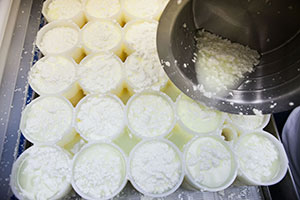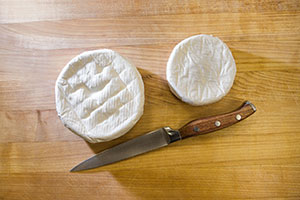Humidity, warmth and a goodly amount of mould aren’t the usual conditions a chef would welcome in his kitchen.
Yet for cheese maker and NAIT instructor Allan Roote, they are essential elements in his effort to bring the joys of cheese to his Culinary Arts students, the public and to a potentially growing cheese-making industry across the province.
Under Roote’s watchful eye, the young chefs make cheese from start to finish as part of their education.
In the immaculately clean cheese room, where the temperature is cranked to 24 C and the humidity is tropical-rainforest high, the students scoop the freshly formed, white curds from the liquid whey and mound them into round molds in a process called “hooping up.”
In 2 or 3 months, each tall mold of curds – formed from a mixture of heated pasteurized milk, rennet and bacterial cultures – will become a round of flavourful brie cheese, offered for sale to the public along with feta, and eventually other varieties, through NAIT’s Retail Meat Store.
Roote also teaches a 4-hour Continuing Education course at NAIT, a hands-on experience in making fresh cheeses like mozzarella, mascarpone and ricotta. The school bookstore even offers a do-it-yourself kit with recipes and everything you need to make fresh cheese at home, except the milk.
“People are shy about tackling [cheese making] because usually the directions aren’t very precise,” says Roote, who has taken specialty cheese-making courses at the University of Vermont and the University of Guelph.
The type of milk, temperature, humidity, amount of cultures added and a host of other variables make cheese making as much an art as a science, he says.
It’s a pursuit very few local entrepreneurs have taken on, especially using cow’s milk, rather than goat or sheep’s milk. Roote would eventually like to branch out into aged cheeses like cheddar, pecorino and blue, which no one in Alberta is currently making from cow’s milk.
 The cheese-making effort at NAIT is the result of a partnership with Alberta Milk and the Alberta Livestock and Meat Agency.
The cheese-making effort at NAIT is the result of a partnership with Alberta Milk and the Alberta Livestock and Meat Agency.
“We’d like to foster the cheese-making industry,” says Melinda Falkenberg-Poetz, marketing coordinator at Alberta Milk, which represents the province’s dairy producers.
“Eating locally produced food is big and it’s a trend that I think is here to stay.”
While artisanal cheese making is popular in Quebec and is growing in B.C., “there really isn’t a cheese centre of excellence in Western Canada,” she says. The organization is hoping to support NAIT to become that centre and, ideally, produce more artisanal cheese makers and more experts to work with bigger cheese producers in Alberta, she adds.
Fostering and growing the cheese-making industry in our province is a move applauded by farm-to-fork restaurateurs like Blair Lebsack (Cook '98), former NAIT instructor and the owner and chef at Edmonton’s acclaimed RGE RD.
“I think all of this is coming from people wanting to know where their food comes from,” he says.
Lebsack has made fresh cheeses like mozzarella and ricotta himself, and his restaurant uses a good selection of Alberta cheeses from producers like Sylvan Star and the Cheesiry as well as the occasional B.C. product.
“We have the skills and the talents to do this and the outstanding milk to do it with,” he adds. “It’s just great to see that people are taking the initiative.”
Culinary Arts student Maria Sandoval hopes to someday own her own restaurant, and says making cheese herself would be a great way to save on costs and produce a high-quality, fresh product.
“Honestly, you see food differently when you work with it more,” she adds. “I taste cheese differently now because you know where it comes from, you know what’s in it, you know you’re the one who handled it.”
Roote says that’s his goal: to give students a stronger connection to the food by playing a role in making it from scratch. “You want to make sure they can see the product and they can touch and feel it and take it home and eat it.” Their cheese education doesn’t stop at making cheese, he adds. They taste and identify about 50 different varieties as part of the program.
 In their own cheese-making, as they’re hooping up the brie into molds, students sample both the curds and some of the nutrient-dense whey that’s left behind, which tastes much like skim milk.
In their own cheese-making, as they’re hooping up the brie into molds, students sample both the curds and some of the nutrient-dense whey that’s left behind, which tastes much like skim milk.
The leftover whey will do double duty in the NAIT kitchens, where it’s used in place of water to make a more flavourful bread, says Roote.
The ingredients that go into the cheese are simple: milk, cultures which turn the milk sugars to lactic acid, and rennet to form the curds, says Roote. The ratio of milk to finished cheese is about 10:1, so 100 litres of milk will make about 10 kg of cheese.
But achieving and recognizing the perfect size and texture of curds to make the finished cheese is a skill born of experience, Roote adds. For young cheeses like brie, the curds should be bigger to keep the moisture content higher. For aged cheese, the curds should be smaller, which makes the cheese drier.
Finishing the job takes patience and commitment. Once it’s in the molds, the cheese drains on a stainless steel table and is flipped every hour for about eight hours. It’s then soaked in a salt brine solution, air dried, put in a 15-degree cooler for a day, then transferred to a second cooler that acts as an artificial cave, mimicking the natural coolness and humidity conducive to making cheese.
That’s where the mould comes in. The cooler is sprayed with Penicillium candidum (purchased from a cheese-making supplier) each day for eight or nine days. The mould attaches to the outside of the cheese and forms a rind. It takes about a month for the flavour of the brie to develop, and about three months for it to reach its prime. All the cheese is analyzed at an off-site lab to ensure it is safe to sell.
Now that the processes are in place to meet the regulatory requirements for testing and labelling, the school’s cheese production can grow and expand based on customer demand, creating more opportunities for budding cheese makers and for the province’s fledgling artisan industry.
Lebsack says the future of such ventures in Alberta looks promising. “We have the processes and the people who can do it now, to be able to make quality, European-style cheese,” he says. “It all comes down to affordability, and the larger the industry becomes, the more that will bring the price down.”